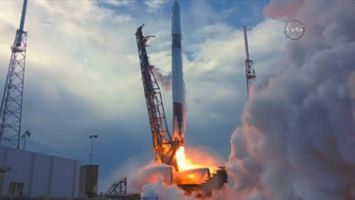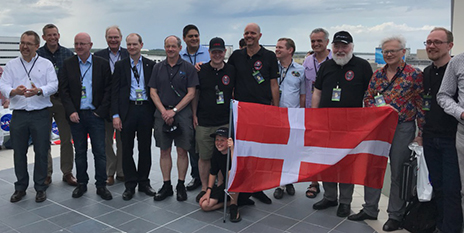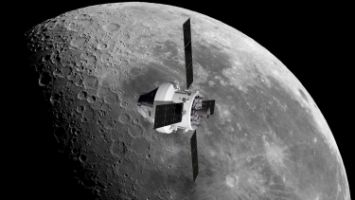Denmark’s largest space project is now in orbit

Five, four, three, two, one… ASIM has now been launched successfully by a SpaceX Falcon 9 rocket from Cape Canaveral in Florida.
Following more than ten years of development, the ASIM observatory has been launched for the International Space Station, ISS, to observe gigantic lightning and Gamma-ray flashes powered by thunderstorms. This took place on 2 April at 22:30 Danish time.
Five, four, three, two, one… Denmark’s largest space project ASIM - The Atmosphere-Space Interactions Monitor - has now been launched successfully by a SpaceX Falcon 9 rocket from Cape Canaveral in Florida.
While the first stage of the booster returned to Earth to be recycled, the second stage, with the unmanned Dragon cargo capsule which holds the ASIM observatory, continued towards the International Space Station, ISS, at 400 km altitude. After 10-12 days, the ASIM instruments will be mounted externally on the European Columbus-module on ISS.
The Danish ESA astronaut Andreas Mogensen – who is stationed at NASA in Houston – participates in the ASIM mission as ‘lead CAPCOM’ (capsule communicator) in the control center. He heads the team which communicates with the astronauts on ISS during the three days it takes for the Dragon capsule to reach ISS and during the subsequent period when the capsule docks at ISS, supplies are unloaded, and instruments are attached on the outside of the ISS.
New knowledge may improve climate models
During the coming years, ASIM will study high-altitude electrical discharges in the stratosphere and mesosphere above severe thunderstorms, the so-called red sprites, blue jets, haloes, and elves. The observatory will in particular measure X- and Gamma rays from thunderstorms and the production of antimatter. Understanding these processes will allow for improved models of greenhouse gas perturbations by thunderstorms, and thereby improved climate prediction models.
"The launch of ASIM is a project we can all be proud of. It is an excellent example of groundbreaking research, development of Danish high technology, and collaboration between universities and industry. At the same time, the new knowledge gained and the fascination of space exploration can be used in education and training and to attract more students to science and technical studies, "says Søren Pind, Danish Minister for Higher Education and Science.
ASIM is a Danish led project implemented by the European Space Agency, ESA. The scientific leadership is within the Technical University of Denmark, DTU Space. The technical consortium is led by the Danish high-tech company Terma. The Danish Meteorological Institute supplies data from meteorological satellites for the ASIM Scientific Data Center at DTU Space.
Huge international interest
According to Scientific Leader and Chair of ESA’s ASIM Facility Science Team Torsten Neubert, DTU Space, an understanding of giant lightning and x-ray flashes will provide new insight into weather and climate. Therefore, there is great international interest from researchers who want to understand what's happening above the clouds:
”One can say that the phenomena that ASIM will observe represent a window into the inner processes of lightning. We expect that ASIM will give us new knowledge of the workings of lightning and thereby improved models for lightning’s influence on the concentration of greenhouse gas in the atmosphere.”
Carsten Jørgensen, Senior Vice President, Terma Space, says:
"It has been a huge and exciting challenge for Terma to head the international team of companies and universities that have been involved in the development of the ASIM instrument over the past 10 years. We look forward to receiving a steady flow of scientific data. In addition, ASIM is equipped with technology that extends into future space exploration missions. Thereby, we gain even more from the investments in ASIM in Denmark. The project has clearly demonstrated that Danish industry, with the Danish research community and international partners, can deliver groundbreaking space technology.
Director at DTU Space Kristian Pedersen is pleased that ASIM has now been launched:
"It is fantastic that ASIM has now been launched into space. The team behind ASIM has delivered great and excellent efforts throughout many years to realize the project. I am very pleased that DTU Space has a leading role in this unique space project," he says.
"With this project, Denmark demonstrates that we are an internationally acclaimed space nation. We develop new, advanced technology and head groundbreaking research projects. It is fascinating to study natural phenomena such as gigantic lightning in the atmosphere, but ASIM will also provide insight into climate processes that can contribute to improved climate models for the Earth. As a result, ASIM will be an inspiration as well as a benefit to Denmark."

Facts about the ASIM project
It has taken more than ten years to develop, build, and test the two instrument packages that will collect and store data in space and send them down to Earth.
The work has taken place in Denmark at DTU Space and Terma as well as at the various European partners: University of Valencia, Spain; University of Bergen, Norway; Space Research Center, Poland; and OHB-Italy, Italy.
ASIM includes the MXGS (Modular X- and Gamma-ray Sensor) instrument package that carries a low- and high-energy detector that measures the energy, direction and arrival time of individual photons.
The payload also includes the MMIA (Modular Multi-spectral Imaging Array) package consisting of two cameras that capture short video sequences of activity and three photometers that measure the light intensity at high time-resolution. The cameras and photometers measure in different color bands.
The Ministry of Higher Education and Science in Denmark has provided funds for the ASIM project. Some of the funding has been provided during the period 2009-2012 from the global funds for climate initiatives via the European Space Agency (ESA). Thereby, it has been possible to strengthen the excellent research, development, and implementation of Danish high technology and the collaboration between universities and the industry.
Additional funding comes from ESA and the universities and companies in the participating countries Norway, Spain, Italy, Poland, and Denmark.
Read more at http://www.space.dtu.dk/





